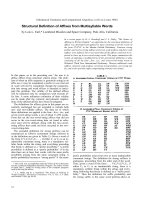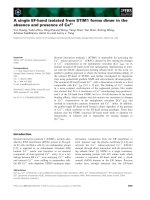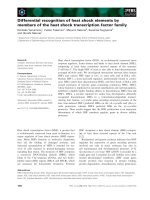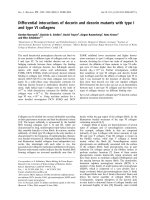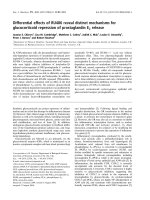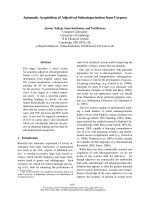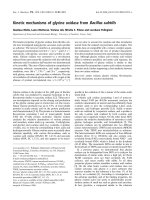Báo cáo khoa học: Differential involvement of protein kinase C alpha and epsilon in the regulated secretion of soluble amyloid precursor protein docx
Bạn đang xem bản rút gọn của tài liệu. Xem và tải ngay bản đầy đủ của tài liệu tại đây (353.85 KB, 8 trang )
Differential involvement of protein kinase C alpha and epsilon
in the regulated secretion of soluble amyloid precursor protein
Cristina Lanni, Michela Mazzucchelli, Emanuela Porrello, Stefano Govoni and Marco Racchi
Department of Experimental and Applied Pharmacology, Centre of Excellence in Applied Biology and School of Pharmacy,
University of Pavia, Viale Taramelli 14, 27100 Pavia, Italy
We investigated the differential role of protein k inase C
(PKC) isoforms in the regulated proteolytic release of
soluble amyloid precursor protein (sAPPa)inSH-SY5Y
neuroblastoma cells. We used cells stably transfected with
cDNAs encoding either PKCa or PKCe in the antisense
orientation, producing a reduction of the expression of
PKCa and PKCe, respectively. Reduced expression of
PKCa and/or PKCe did not modify the response of the
kinase to phorbol ester stimulation, demonstrating translo-
cation of the respective isoforms from the cytosolic fraction
to specific intracellular compartments with an interesting
differential l ocalization of PKCa to the plasma me mbrane
and P KCe to Golgi-like structures. Reduced expression of
PKCa significantly impaired the secretion of s APPa induced
by treatment with phorbol esters. Treatment o f PKCa-
deficient cells with carbachol induced a s ignificant release of
sAPPa. T hese results s uggest that the i nvolvement of PKC a
in carbachol-induced sAPPa release is negligible. The
response to carbachol is instead completely blocked in
PKCe-deficient cells suggesting the importance o f PKCe in
coupling cholinergic receptors with APP metabolism.
Keywords: A lzheimer’s disease; cholinergic receptors; neuro-
blastoma; phorbol esters; signal transduction.
Alzheimer’s disease (AD), the most common type of
dementia, is characterized by deposition in the brain of
fibrillar aggregates of a peptide named beta-amyloid (Ab),
derived from p roteolytic processing of a larger precursor
called amyloid precursor protein (APP) [1]. APP is meta-
bolized by several alternative pathways: in the secretory
pathway, it is cleaved extracellularly within the Ab domain
by a-secretase to generate a soluble nonamyloidogenic
fragmentofAPP(sAPPa) that is secreted in the c onditioned
medium of cell cultures, human plasma and in the
cerebrospinal fluid. Other enzymes, b-andc-secretase,
cleave APP at the N and C termini of Ab, respectively,
releasing the amyloidogenic peptide [2,3].
APP processing by a-secretase occurs via a constitutive
pathway and by receptor-mediated activation of multiple
signal trasduction pathways among which protein kinase C
(PKC) is a major player.
PKC is a family of at least 12 isoenzymes of serine/
threonine protein kinases, central to many sign al transduc-
tion pathways [4]. Although these isoenzymes share a
similar structural domain organization, differences in their
substrate specificity, cofactor requirements, tissue and
cellular d istribution, and subcellular l ocalization s uggest
that each of the different PKC isoenzymes p lays a specific
and distinct regulatory role in cellular signal transduction
[4–8].
The role of i ndividual PKC isoforms in the regulation of
APP proteolytic processing is not yet understood. Recently
we demonstrated that PKCa was specifically involved in
phorbol ester-induced sAPP a release [9], further supporting
a series of reports that pointed to a specific role for PKCa
in APP p rocessing in v itro (for review see [2]), and most
recently a lso in vivo [1 0,11] where constitutive overactivation
of PKCa an d PKCb isoforms in guinea pig brain were
shown to increase sAPPa production.
In this work we sought to differentiate the role played by
PKCa and PKCe in the r egulated processing of APP. There
is substantial evidence in the literature for a significant role
of PKCe both in the regulation of APP metabolism [11–14]
and in the pharmacology of muscarinic receptor signalling
[15]. PKCe is one of the most e xtensively studied Ca
2+
-
independent isoenzymes of the PKC family. PKCe may
participate in the regulation of diverse functions in cells of
various origin, including the modulation o f gene expression
[16], Raf-1 mitogenicity [17], neoplastic transformation
[18,19], cell adhesion [20], extension and maintenance of
motile cellular protrusions [21], contraction in smooth
muscle cells [22] and cardiomyocytes [23], and finally
secretory vesicle trafficking [24]. PKCe is a typical multi-
domain protein in which the overall struc tural organization
has been conserved in orthologous genes from yeast to
mammals. H owever, i n mammals, PKCe has acquired short
sequence m otifs i n t he regulatory N-terminal region that are
not evident in invertebrates (AplII of Aplysia and PKC
d98F of Drosophila [25]) and are postulated to function
as localization signals in the subcellular targeting of this
protein kinase.
The a im of our study was t o characterize and differentiate
theroleofPKCa and PKCe in the r egulated secretion o f
Correspondence to M. Racchi, Department of Experimental and
Applied Pharmacology, Viale Taramelli 14, 27100, P a via, Italy.
Fax: +39 0382507405, Tel.: +39 038250 7738,
E-mail:
Abbreviations:Ab, beta-amyloid; AD, Alzheimer’s disease; APP,
amyloid precursor protein; P K C, protein kinase C; P MA, 4b-phorbol
12-myristate 13-acetate.
Note:C.LanniandM.Mazzucchellicontributed equ ally to this work.
(Received 2 March 2004, revised 6 May 2004, accepted 1 June 2004)
Eur. J. Biochem. 271, 3068–3075 (2004) Ó FEBS 2004 doi:10.1111/j.1432-1033.2004.04240.x
sAPPa. We have therefore studied the d irect and receptor-
mediated activation of PKC in a cellular model of
downregulation o f PKCe and/or PKCa to understand the
respective roles of these specific isoforms of PKC in the
activation of APP proteolytic processing.
Materials and methods
Materials
All c ulture media, supplements and foetal c alf serum were
from Gibco Life T echnologies. Electrophoresis reagents
were from Bio-Rad. All other reagents were of t he highest
grade available and were purchased from Sigma Chemical
Co. unless o therwise indicated. 4b-Phorbol 12-myristate
13-acetate (PMA), PD98059 (Alexis Biochemicals, San
Diego, CA, USA) w ere dissolved in dimethyl sulfoxide and
stored at )20 °C. Stock s were diluted in serum-free medium
before the experiments. Carbachol was dissolved and
diluted to working concentration in serum-free minimum
essential medium (MEM) at the moment of use.
Cell cultures and experimental treatments
SH-SY5Y neuroblastoma cells were cultured in Eagle’s
MEM supplemented with 10% foetal bovine serum,
penicillin/streptomycin, nonessential amino acids and
sodium pyruvate (1 m
M
)at37°Cin5%CO
2
/95% air.
The cell line with s table antisense downregulation of PKCe
was provided by T . B. Shea (McLean Hospital, Boston,
MA, USA) and was grown in the same medium with the
addition of the s electing agent G418 (Gibco Life Technol-
ogies) at 400 lgÆmL
)1
.Fortheexperiments,4· 10
6
cells
were seeded in 60-mm dishes and c ultured for 48 h. Prior to
the experiment confluent monolayers of cells were washed
twice with NaCl/P
i
and once with serum-free culture
medium. Experimental treatments for the detection of
sAPPa released into the conditioned medium were per-
formed in serum-free MEM w ith incubation for 2 h at
37 °C. Experiments for the detection of activated MEK
were performed with incubations of 10 min. In all experi-
ments involving the use of inhibitors such as PD98059, the
compounds were preincubated for 30 s prior to the addition
of PMA or carbachol.
Immunodetection of sAPPa and PKC
Conditioned medium w as collected after 2 h of incubation
and centrifuged at 13 000 g for5mintoremovedetached
cells and debris. Proteins in the medium were p recipitated
quantitatively b y t he deoxychol ate/trichloroacetic acid pro-
cedure as described previously [26]. Cell monolayers were
washed twice with ice-cold NaCl/P
i
and lysed on the tissue
culture dish b y a ddition of ice -cold lysi s buffer ( 50 m
M
Tris/
HClpH7.5,150m
M
NaCl, 5 m
M
EDTA, 1% Triton X-
100). An aliquot of the cell lysate was used for protein
analysis with the Bio-Rad Bradford kit for protein quan-
tification. Normalization of p rotein loading on each blot
was obtained by load ing a volume o f sample of conditioned
medium standardized to total cell lysate protein concentra-
tion. Proteins were subjected to SDS/PAGE (10%) and
then tran sferred onto poly(vinylidene difluoride) (PVDF)
membrane (DuPont NEN). The membrane was blocked for
1 h with 10% nonfat dry milk in Tris-buffered saline
containing 1% Tween-20. For the detection o f s APPa,
membranes were immunoblotted with the antibody 6E10
(Chemicon-Prodotti Gianni, Milan, Italy). Detection was
carried out by incubation with horseradish peroxidase-
conjugated goat anti-mouse IgG (Kirkegaard and Perry
Laboratories, Gaithersburgh, MD, USA) for 1 h as secon-
dary antibod y. The blots were then washed extensively and
sAPPa visualized using an enhanced chemiluminescent
methods ( Pierce, Rockford, IL, USA). For the detection of
PKC, cells were homogenized in a buffer containing 20 m
M
Tris/HCl pH 7.5, 2 m
M
EDTA, 0 .2 m
M
phenylmethylsulfo-
nyl fluoride, 20 lgÆmL
)1
leupeptin, 25 lgÆmL
)1
aprotinin
and 0.5% Triton X-100. Proteins were measured as
described earlier and subjected to Western blot analysis
with the method indicated previously using i soform-specific
mAb from Transduction Labo ratories (Lexington, KY,
USA) and from Santa Cruz Biotechnology.
Western blot for ERK phosphorylation
SH-SY5Y cells were cultured in serum-free medium over-
night before stimulation with agonists for 10 min with or
without 30 min of preincubation with PD 98059. After
stimulation, the cells were lysed in lysis buffer (62.5 m
M
Tris/HCl pH 6.8, 2% SDS, 10% glycerol, 50 m
M
dithio-
threitol, 0 .1% Bromphenol blue). Cells lysates were boiled
for 5 min and the n ce ntrifuged at 10 0 00 g at room
temperature for 5 min; then 25 lLofthelysatewere
separated by SDS/PAGE on 10% acrylamide and proteins
subjected to electrophoretic transfer to PVDF membranes.
Blots were probed with either a rabbit polyclonal antibody
specific for ERK (p44/p42 MAP kinase) (New England
Biolabs) or a mAb for phosphorylated ERK (phospho-44/
42 MAP kinase) (Upstate Biotec. Inc., Lake Placid, NY,
USA), and developed by chemiluminescence following
incubation with the appropriate horseradish-peroxidase
conjugated secondary antibody.
Immunocytochemical analysis of PKC translocation
SH-SY5Y neuroblastoma cells were seeded on glass cover-
slips a t a density of 5 · 10
5
viable cells per well in a 24-well
plate. Cells on coverslips were treated with PMA 100 n
M
in
Krebs buffer for 5 or 15 m in, whereas control cells were
incubated w ith vehicle (dimethyl sulfoxide) a lone in Krebs
buffer for 5 m in.
After treatment, cells were fixed in ethanol 70% at
)20 °C, washed with NaCl/P
i
and permeabilized for 15 min
at room temperature with 0.01% Triton X-100 in NaCl/P
i
.
To quench e ndogenous peroxidase activity, cells were
treatedwithNaCl/P
i
containing 3% h ydrogen peroxide
and 10% methanol for 15 min; nonspecific binding with
PKCa and PKCe was blocked by incubation for 30 min
with NaCl/P
i
containing 1% BSA. Cells were incubated for
1 h with antibodies specific for PKCa or PKCe, diluted
1:50inNaCl/P
i
/1% BSA s olution. Cells wer e washed with
NaCl/P
i
and then incubated for 1 h at room temperature
with an antirabbit I gG antibody conjugated with fluorescein
isothiocyanate (FITC; Calbiochem, Inalco S.p.A., Milan,
Italy) diluted 1 : 4500 in NaCl/Pi/1% BSA. After the
Ó FEBS 2004 Differential role of PKC isoforms in APP processing (Eur. J. Biochem. 271) 3069
fluorescent labelling proc edures, cells were finally counter-
stainedforDNAwithfor5minwitha0.1lgÆmL
)1
HOECST 33342 solution in NaCl/P
i
, and mounted upside
down on glass slides, in a drop of Mowiol (Calbiochem).
Images were obtained with a confocal microscope Leica
DM IRBE with a software Leica TCS SP.
Densitometry and statistics
Following acquisition of the Western blot image through an
AGFA scanner and analysis by means o f the
NIH IMAGE
1.47 program (Wayne Rasband, NIH, Research Services
Branch, N IMH, B ethesda, M D, USA), the relative densities
of the bands were expressed as arbitrary units and
normalized to data obtained from control sample run
under the same conditions. Controls were processed in
parallel with stimulated samples and always included in the
same blot. Pre liminary experiments with serial diluitions of
secreted protein allowed determination of optimal linear
range for chemiluminescen ce reaction. Data were analysed
using t he analysis of variance test followed, when significant,
by an appropriate post hoc comparison such as the
Dunnett’s or Student’s t-t est; a P value < 0.05 was
considered significant. The data reported are expressed as
mean ± SD of at least three independent experiments.
Results
SH-SY5Y human neuroblastoma cells spontaneously
express M
1
and M
3
muscarinic receptors, making them
particularly suitable for the characterization of PKC-
dependent and r eceptor-mediated APP metabolism. Besides
the parental SH-SY5Y cells (SY-wt), we obtained a cell line
transfected with an expression plasmid containing PKCa
antisense cDNA (SYa4) and a cell line transfected with an
expression plasmid containing PKCe antisense cDNA
(SYDe) [27]. Western blot analysis showed that in SYa4
neuroblastoma cells, the expression of PKCa immuno-
reactivity is significantly reduced ()66.4% ± 3.4;
mean ± SD o f t riplicate samples) compared to t h e parental
cell line (Fig. 1A). Differences were not observed in the
expression of PKCd, bI, bII and e isoforms between SY-wt
and SYa4 cells (Fig. 1A). Similarly, immunoblot analysis of
SYDe neuroblastoma cells showed a significant reduction in
the e xpre ssion of PKCe ()69.4% ± 10.7; mean ± SD of
triplicate samples), compared to the parental cell line
(Fig. 1 B). No differences were found in the expression of
PKCd, bIandbII; however, a decrease in the expression of
PKCa ()57.3% ± 15.5; mean ± SD of triplicate samples)
was observed (Fig. 1B).
Activation of PKC was determined by examining
translocation of cytosolic PKC t o a particulate membrane
fraction, because PKC activation involves a stable associ-
ation of PKC with membranes [4,7,8]. In order to show
also the subcellular compartment where translocation
takes place we subjected the cells to immunocytochemical
analysis and confocal microscopy. PKCa (Fig. 2 ) and
PKCe (Fig. 3) were detected predominantly in the cyto-
plasm of untreated cells; stimulation of the cells with
PMA induced a translocation of cytosolic PKCa to
structures probably corresponding to the plasma mem-
brane (Fig. 2B,C,E,F). Although the reduced immuno-
reactivity of PKCa in the SYa4 cells is e vident a lso i n the
immunocytochemical images (Fig. 2D) the phorbol ester
stimulation contributes to the translocation of the residual
immunoreactive PKCa tothesameplasmamem-
brane compartment as shown in the parental cell line
(Fig. 2 E,F). The translocation of PKCe was followed in
SYDe cells in comparison with the parental SYwt cells.
PKCe isoform appears to translocate, following challenge
with phorbol ester, to ÔGolgi-lik eÕ structures (Fig. 3B,C,E,F),
consistent with its putative role as regulator of Golgi
functions [28]. As discussed before for PKCa, the reduced
expression of PKCe in SYDe cells, d id not modify the ability
of the residual kinase t o t ranslocate to the same i ntracellular
compartments.
Fig. 1. Evaluation by Western blotting of the
expression o f PKC isoforms in S Ya4 and SYDe
as compared to that in SYwt neuroblastoma
cells. Cell lysate proteins were p robed with
mouse anti-PKC mAb. Samples of rat cere-
bellum homogenate were included as positive
controls and for molecular s ize identifi cation
(data not shown). (A) Comparison of the
pattern of e xpression o f PKC i n S Ya4tothat
in SYwt. PKCa is the only iso form with re-
duced expression while PKCe, d, bIandbII
show no differences. ( B) In SYDe, in addition
to the e xpected reduced expression of PKCe,
reduced expression of PKCa was also ob-
served, with no changes in the other isofo rms
of the kinase. Tubulin Western blot images are
included as loading controls.
3070 C. Lanni et al. (Eur. J. Biochem. 271) Ó FEBS 2004
We demonstrated previously that downregulation of
PKCa significantly affects PMA-induced sAPPa release [9],
without affecting carbachol-regulated APP processing. We
now eval uated how downregulation o f P KCe may affect the
processing of APP. Parental SYwt and SYDe cells were
treated with increasing concentrations of PMA (10 n
M
–
1 l
M
)for2handsAPPa was measured in conditioned
medium by Western blot. As shown in Fig. 4, SYwt
Fig. 2. Fluorescence micrographs o f SYwt and SYa4 cells after treatment with PMA 100 n
M
for 5 or 15 min. FITC-immunolabelling for PKCa;
nuclear DNA was counterstained with Hoechst 33342 (magnification, · 63).
Fig. 3. Flu oresc ence micrographs of SYwt and SY De cells after treatment with PMA 100 n
M
for 5 or 15 min. FITC-immunolabelling for PKCe;
nuclear DNA was counterstained with Hoechst 33342 (magnification, · 63).
Ó FEBS 2004 Differential role of PKC isoforms in APP processing (Eur. J. Biochem. 271) 3071
stimulated with PMA, showed a significant increase in
sAPPa release compared to basal levels and reached a
maximum of approximately threefold increase at 1 00 n
M
PMA. In contrast SYDe showed a slight and not significant
increase in sAPPa release at all concentrations of PMA
tested. This pattern is similar to that observed in SY a4 cells
[9] and may be due not only to PKCe down regulation but
also to the fact that SYDe cells show reduced expression of
PKCa in addition to PKCe.
The cellular model of SH-SY5Y cells was chosen in
particular because of endogenous expression of muscarinic
receptors, the stimulation of which is coupled to increased
release of sAPPa. In our p revious experiments, as well as
in the current set of data, in spite of reduced expression of
PKCa,SYa4 cells demonstrated a complete response to
carbachol stimulation in terms of sAPPa release [9] (Fig. 5)
suggesting that the defective i soform was not involved in the
receptor-mediated activation of APP processing.
Treatment of SYDe with increasing concentrations of
carbachol did not elicit a significant release of sAPPa,in
contrast to parallel experiments conducted on SYwt and
SYa4 cells which responded to carbachol with a concen-
tration-dependent increase in sAPPa release with a maxi-
mally effective concentration of 1 m
M
(Fig. 5). The W estern
blot inset in Fig. 5 is an example showing the complete lack
of response to carbachol of SYDe cells.
As the pathway downstream of muscarinic receptors is
complex and involves the activation of ERKs a nd the
MAP-kinase pathway we studied whether t he downregula-
tion of PKCe influences the activation of MEK in our
cellular models. We previously demonstrated that in
SH-SY5Y cells the activation of the MAP-kinase pathway
is not significantly involved in the carbachol-regulated
sAPPa release and it is not affected by PKCa downregu-
lation [9]. Similarly the treatment of SYDe ce lls with
carbachol for 10 min resulted in a significant increase in the
phosphorylation of E rk-1 and E rk-2 (Fig. 6) in a way
quantitatively similar to that of the parental SYwt cell line.
In addition stimulation of Erks phosphorylation was
inhibited by PD-98059 in both cell lines.
Fig. 4. Se cret ion of sAPP a following PM A treatment of SYwt, SYa4
and SYDe neuroblastoma cells. Incubation of the cells for 2 h in the
presence of in creasing con centrations of PMA (10 n
M
,100n
M
,1l
M
)
was followed by Western blot of proteins co llected from th e condi-
tioned media. Data are expressed as percentage of basal r elease and are
representative of three to four independent experiments. *P <0.05
compared to the same data for SYwt cells.
Fig. 5. Secretion of sAPPa following carbachol treatment in SYwt,
SYa4 and SY De neuroblastoma c ells. Incubation of the cells for 2 h in
the presence of increasing concentratio ns of carbachol (10 l
M
,100 l
M
,
1m
M
) was followed by Western blot of proteins collected from t he
conditio ned media. Data are exp ressed as percentage of basal relea se
and are representative of thre e to four in dependent e xperiments.
*P < 0 .05 compared to the same data for SYwt cells. The inset
Western b lot represent an example of the pattern of sAPP a release
obtained by treatment with carbachol 1 m
M
.
Fig. 6. Erk1/Erk2 p hosphorylation following tr eatment with c arabachol
in SYwt and SYDe cells. As indicated b y equal activation of Erk1/Erk2
phosphorylation the MAP-kinase pathway is not affe cted by PK Ce
and PKCa downregulation. Cells were preincubated overnight with
serum-free MEM and then treated f or 10 min with carbachol (1 m
M
)
following a 30- min pretreatment with vehicle or PD 98059 (50 l
M
).
Cell lysates were collected as indicatedinMaterialsandmethodsand
probed on a Western blot with phospho-specific antibodies (upper
panel) and antibodies to Erk1/Erk2 (lo wer panel) to correct for protein
loading.
3072 C. Lanni et al. (Eur. J. Biochem. 271) Ó FEBS 2004
Discussion
Here we demonstrate that PKCe is specifically involved
in carbachol-mediated activation of sAPPa release in
SH-SY5Y cells. Our goal was to demonstrate the differen-
tial involvement of PKC isoforms in APP processing
resulting either from direct activation o f PKC by phorbol
esters or by indirect receptor-mediated activation.
It is known that among multiple signal transduction
molecules, different isoforms o f PKC may be involved and
can specifically contribute to t he complex regulation of A PP
metabolism. Many of the signal t ransduction mechanisms,
neurotransmitter receptors and other receptor ligands
involved in APP processing regulation, have been described
as defective in AD [29] and in some cases these d efects have
been associated with aberrant APP metabolism [26,30–32].
PKC was one o f the first signal transduction-related
molecules t o be implicated in the regulation of APP
metabolism [2,3] suggesting, in particular, that the nona-
myloidogenic a-secretase pathway is activated by PKC.
This simplification may not reflect the f ull c omplexity of t he
system, yet it is inte re sting to note t hat d efective PKC i s one
of the most consistent findings i n AD brain an d peripheral
tissues [29,33]. In fibroblasts from AD patients defective
APP metabolism is paralleled by a specific downregulation
of PKCa [26]. The same extent of protein expression
reduction was reproduced when using a neuroblastoma cell
line stably e xpressing the cDNA for PKCa in the antisense
orientation (SYa4). We have shown that the pattern of
response to phorbol ester s hown by the SYa4cell line [9] is
remarkably similar to that of AD fibroblasts [26], support-
ing the suggestion that the loss of a high-affinity bindin g site
for phorbol esters due to downregulation of PKCa reduces
the sensitivity of the cells to direct PKC activation. Higher
concentrations of PMA are necessary to elicit a significant
secretion of sAPPa in SYa4 cells, perhaps necessary for the
activation of Ca2
+
-independent PKCs such as PKCe.
In fact, the pattern of response to phorbol ester in a
neuroblastoma cell line stably expressing the cDNA for
PKCe in antisense orientation (SYDe) is different from that
showninSYa4 cells in that the response is completely
abolished. It should be noticed that in SYDe the antisense
strategy has resulted not only in reduced expression of
PKCe but also to reduced expression of PKCa, perhaps
because of common overlapping sequences. The significant
downregulation of t he two isoforms is however, sufficient to
abolish completely the effect of phorbol esters on sAPPa
release in spite of the presence of unchanged levels of two
other C a2
+
-dependent PKC isoforms, PKC bIandbII, a nd
at least one Ca2
+
-independent isoform, PKCd.
The downstream e ffect o f d ifferent PKC isoforms is o ften
dependent upon redistribution o f the kinase to specific
intracellular compartments. Inactive cytosolic-resident pro-
tein kinases may be recruited to perform distinct functions
based on the localization signals that they have received,
and t heir m icroenvironment a t t he time of activation. In this
study we show a different PMA-induced redistribution of
PKCa and PKCe isoforms in SH-SY5Y cells. While PKCa
translocated from the cytosolic compartment to the plasma
membrane, PKCe translocation was evident from the
cytosolic fraction to Golgi-like structures as early as 5 min
after PMA treatment. This data is interesting and is
consistent with reports that suggested that PKCe may be
involved in regulating Golgi-related processes [28]. Lehel
et al . demonstrated in NIH-3T3 ce lls that the zinc-finger
domain of PKCe was found to contain all of the informa-
tion necessary for exclusive localization to the Golgi
network and that both the holoenzyme and its zinc finger
region modulate Golgi function. It is interesting also to
observe that a different translocation and redistribution of
PKCa and PKCe isoforms could be correlated to a
differential involvement in the regulation of APP process-
ing. In cell-free systems it has been shown that activation of
endogenous PKC increases formation from the trans-Golgi
network (TGN) of secretory vesicles containing APP,
suggesting a role for PKC in the regulation of secretory
vesicle formation [34]. Furthermore Skovronsky and col-
leagues [35] have shown that r egulated a-secretase APP
cleavage can occur in the TGN by specific detection of T GN
resident a-secretase a ctivity following PKC activation.
In addition to the reports suggesting a s ignifcant role for
PKCa in phorbol ester r egulated sAPP a release a number o f
reports in the literature indicate that PKCe is equally, if not
exclusively, involved. Kinouchi et al. showed initially that
an increased release of sAPP a could be induced by
overexpression of PKCe in 3Y1 cells. These results were
also obtained by overexpression of PKCa but not by
overexpression of PKCd [12]. Inhibition of PKCe was
instead obtained with strategies involving the overexpres-
sion of the PKCe V1 region, which binds specifically to the
receptor for activated C-kinase (RACK), blocking the
activation of the kinase specifically [13]. These experiments
resulted in a reduced release of sAPPa following phorbol
ester treatment; however, the data were obtained in B103
neuroblastoma cells overexpressing APP. Those cells
reportedly do not express endogenous APP and therefore
may not includ e the completely physiological machiner y for
APP p rocessing. F inally, expression of a peptide inhibitor of
PKCe resulted in the inhibition of phorbol ester-induced
sAPPa release [14]. It is worth mentioning that the
involvement of PKCa in these experiments has been ruled
out b ecause of the lack of inhibition by Go
¨
6976, which is a
specific inhibitor o f C a
2+
-dependent isoforms. In our hands
the inhibitor Go
¨
6976 can always block the phorbol ester
induced sAPP a release to a significant extent [9,36] yet it w as
of particular interest that Go
¨
6976 did not block the
carbachol-mediated release of sAPPa in SYwt and SYa4
cells [9], an in dication that while PKC a was clearly involved
in p horbol ester-mediated APP processing it was not
necessary for receptor-mediated activation of sAPP a
release. The s timulation of G-protein coupled receptors by
neurotransmitters can regulate APP processing by PKC-
dependent signalling pathways. In our cell system, as in
others in the literature, the cholinergic receptor stimulation
of sAPPa release can be blocked by GF109203X [9,37,38]
suggesting clear involvement of PKC-dependent mechanism
although not related to C a
2+
-dependent isoforms of the
kinase. Our experiments show that response to carbachol is
completely blocked in SYDe, clearly indicating that PKCe
may play a crucial role in receptor-mediated sAPPa release.
This suggestio n is consistent with data in the literature that
indicate PKCe as the only protein kinase isoform involved
in the s ignalling pathway downstream of muscarinic m3
receptors in SK-N-BE(C) neuroblasto ma cells [15]. The
Ó FEBS 2004 Differential role of PKC isoforms in APP processing (Eur. J. Biochem. 271) 3073
signalling pathways downstream of muscarinic receptors
involve both PKC-dependent and -independent mecha-
nisms c oupled to the activation o f the MAP-kinase pathway
[39]. It w as shown that MAP-kinase a ctivation c an be
obtained downstream of muscarinic receptors by a mech-
anism involving the activation of Src tyrosine kinase [39]
without involving PKC activity. The fact that downregula-
tion of PKC a [9] and PKCe do not modify the possibility t o
activate MAP-kinase following carbachol treatment is
consistent with the presence of a redundant signalling
pathway downstream of the cholinergic receptor. In addi-
tion, the f act that sAPPa release followin g treatment w ith
carbachol is completely blocked i n SYDe regardless of a full
activation of MAP-kinase demonstrates that the latter
signalling system is not involved in the carbachol-mediated
regulated processing of APP in these cells.
In summary, the results indicate that PKCa and PKCe
have differential roles in the regulation of APP processing
and sAPPa release in SH-SY5Y cells – the former being
involved predominantly i n the response to direct activation
of the kinase and the latter being involved exclusively in
muscarinic re ceptor r egulated sAP Pa release, a r ole possibly
extended to other G-protein coupled receptors.
Acknowledgements
We are grateful to Dr Thomas B. Shea of the McLean Hospital,
Boston, MA, USA for the gift of SYa4andSYDe ce lls. This work w as
made p ossible through grants from the I talian MIUR (prot. #
2003057355–2 003 a nd pr ot # MM05221899–2000 to S. G.), from the
University of Pavia ( FAR 2003 to M. R .; Progetto Giovani Rice rcatori
to M. M., C. L. and E. P.) a nd from the Italian Ministry of H ealth
(Progetto Finalizz. Alzheimer to S. G. and to M. R.).
References
1. Hardy, J. & Selkoe, D.J. (2002) The amyloid hypothesis of Alz-
heimer’s disease: progress and problems on the road to thera-
peutics. Science 297, 353–356.
2. Racchi, M. & Govoni, S. (2003) The p harmacology of amyloid
precursor protein processing. Exp. Gerontol. 38, 145–157.
3. Racchi, M. & Govoni, S. (1999) Rationalizing a pharmacological
intervention on th e amyloid p recursor protein metabolism. Trends
Pharmacol. Sci. 20, 418–423.
4. Nishizuka, Y. (1995) Protein kinase C and lipid signaling for
sustained cellular r esponses. FASEB J. 9, 484–496.
5. Dekker, L.V. & Parker, P.J. (1994) Protein kinase C -a qu estion of
specificity. Trends Biochem. Sci. 19, 73–77.
6. Kampfer, S., U berall, F., Giselbrecht,S.,Hellbert,K.,Baier,G.&
Grunicke, H.H. (1998) Characterization of PKC isozyme specific
functions in cellular s ignaling. Adv. Enzyme Regul. 38, 35–48.
7. Csukai, M. & Mochly-Rosen, D. (1999) Pharmacologic modula-
tion of protein kin ase C isozym es: the role of RACKs and sub-
cellular localisation. Pharmacol. Res. 39, 253–259.
8. Kanashiro, C.A. & Khalil, R.A. (1998) Signal transduction by
protein kinase C in mammalian cells. Clin. Exp. Pharmacol.
Physiol. 25, 974–985.
9. Racchi, M., Mazzucchelli, M., Pascale, A., Sironi, M. & Govoni,
S. (200 3) Role of prote in kinase C alpha in the regulated secretion
of the amyloid precursor protein. M ol. Psychiatry 8, 209–216.
10. Rossner, S., Mendla, K., Schliebs, R. & Bigl, V. (2001) Protein
kinase Calpha and beta1 isoforms are regulators of alpha-secre-
tory proteolytic processing of amyloid precursor protein in vivo.
Eur. J. Neurosci. 13, 1644–1648.
11. Rossner,S.,Beck,M.,Stahl,T.,Mendla,K.,Schliebs,R.&Bigl,
V. (2000) Constitutiv e overactivation of protein kina se C in guinea
pig brain increases alpha-secretory APP processing without
decreasing beta-amyloid generation. Eur. J. Neurosci. 12, 3191–
3200.
12. Kinouchi, T., Sorimachi, H., Maruyama, K ., Mizuno, K., O hno,
S., Ishiura, S . & Suz u ki, K. (1995) Conventional pr otein kinase C
(PKC)-alpha and novel PKC epsilon, but not -delta, increase the
secretion of an N-terminal fragment of A lzheimer’s disease amy-
loid precursor p rotein from PKC cDNA transfected 3Y1 fib ro-
blasts. FEBS Lett. 364, 203–206.
13. Yeon, S.W., Jung, M.W., Ha, M .J., Kim, S.U., Huh, K., Sav age,
M.J., Masliah, E. & Mook-Jung, I. (2001) Blockade of PKC
epsilon activation at tenuates p horbol este r-induced in crease of
alpha-secretase-derived secreted form of amyloid precursor p ro-
tein. Biochem. Bioph ys. Res. Comm. 280, 782–787.
14.Zhu,G.,Wang,D.,Lin,Y.H.,McMahon,T.,Koo,E.H.&
Messing, R.O. (2001) Protein kinase C epsilon suppresses Abeta
production and promotes activation of alp ha-secretase. Biochem.
Biophys. Res. Comm. 285, 997–1006.
15. Kim,J.Y.,Yang,M.S.,Oh,C.D.,Kim,K.T.,Ha,M.J.,Kang,
S.S. & Chun, J.S. (1999) Signalling pathway leading to an acti-
vation of mitogen-activated protein kinase by stimulating M3
muscarinic receptor. Biochem. J. 337, 275–280.
16. Reifel-Miller, A. E., Conarty, D.M., Valas ek, K.M., Iversen, P.W.,
Burns, D.J. & Birch, K .A. (1996) Protein kinase C isozymes dif-
ferentially regulate promoters containing PEA-3/12-O-tetradeca-
noylphorbol-13-acetate response element motifs. J. Biol. Chem.
271, 21666–21671.
17. Cacace, A.M., Ueffing, M., Philipp, A., Han, E.K., Kolch, W. &
Weinstein, I.B. (1996) PKC epsilon functions as an oncogene
by e nha ncing activation of the Raf kinase . Oncogene 13, 2517–
2526.
18. Mischak, H., Goodnight, J.A., Kolch. W., Martiny-Baron. G.,
Schaechtle, C., Kazanietz, M.G., Blumberg, P.M., Pierce, J.H. &
Mushinski, J.F. (1993) Overexpression of protein kinase C- delta
and -epsilon in N IH 3T3 cells in duc es op posite e ffec ts o n g rowth,
morphology, anchorage depende nce, and tumorige nicity. J. Biol.
Chem. 268, 6090–6096.
19. Perletti, G., Tessitore, L., Sesc a, E., Pani, P., Dianzani, M.U. &
Piccinini, F. (1996) Epsilon PKC acts like a marker of progressive
malignancy in rat liver, b ut fails to enhance tumorigenesis in rat
hepatoma cells in culture. Biochem. Biophys. Res. Commun. 221,
688–691.
20. Chun,J.S.,Ha,M.J.&Jacobson,B.S.(1996)Differentialtrans-
location of protein kinase C epsilon during HeLa cell adhesion to a
gelatin substratum. J. Biol. Chem. 271, 13008–13012.
21. Fagerstrom, S., Pahlman, S., Gestblom, C. & Nanberg, E. (1996)
Protein kinase C-epsilon is implicated in neurite outgrowth in
differentiating human neuroblastoma cells. Cell Growth Differ. 7,
775–785.
22. Horowitz, A., Clement-Chomienne, O., Walsh, M.P. & Morgan,
K.G. (1996) Epsilon-isoenzyme of protein kinase C induces a C a
(2+)-independent contractio n in vascular smooth m uscle. Am. J.
Physiol. 271, 589–594.
23. Huang,X.P.,Pi,Y.,Lokuta,A.J.,Greaser,M.L.&Walker,J.W.
(1997) Arachidonic acid stimulates protein kinase C-epsilon
redistribution in heart cells. J. Cell Sci. 110, 1625–1634.
24. Prekeris, R., Mayhew, M.W., Cooper, J.B. & Terrian, D.M.
(1996) Identification and localization of an actin-binding motif
that is unique to the epsilon isoform of protein kinase C and
participates in the regulation of synaptic function. J. Ce ll Biol. 132,
77–90.
25. Sossin, W.S., Diaz-Arrastia, R. & Schwartz, J.H. (1993) Char-
acterization of tw o isoforms of protein kinase C in t he nervous
system of Aplysia californica. J. Biol. Chem. 268, 5763–5768.
3074 C. Lanni et al. (Eur. J. Biochem. 271) Ó FEBS 2004
26. Bergamaschi, S., Binetti, G., Govoni, S., Wetsel, W.C., Battaini,
F., Trabucchi, M. & Racchi, M . ( 1995) D efective phorbol ester-
stimulated secretion of beta-amyloid precursor protein from Alz-
heimer’s disease fibroblasts. Neurosci. Lett. 201,1–5.
27. Boyce, J.J. & Shea, T.B. (1997) Phosphorylation events mediated
by protein kinase C alpha and epsilon p articipate in regulation of
tau steady-state levels and generation of certain ÔAlzheimer-likeÕ
phospho-epitopes. Int. J. Dev Neurosci. 15, 295–307.
28. Lehel, C., Olah, Z., Jakab, G. & Anderson, W.B. (1995) Protein
kinase C e psilon is localized to the Golgi via i ts zinc-finger domain
and modulates Golgi function. Proc. Natl Acad. Sci. USA 92,
1406–1410.
29. Gasparini, L., Racchi, M., Binetti, G., Trabuc chi, M., Solerte,
S.B.,Alkon,D.,Etcheberrigaray, R., Gibson, G., Blass, J.,
Paoletti, R. & Govoni, S. (1998) Peripheral markers in testing
pathophysiological hypotheses and diagnosing Alzheimer’s dis-
ease. FASEB J. 12, 17–34.
30. Vestling, M., Cedazo-Minguez, A., Adem, A., Wiehager, B.,
Racchi, M., Lannfelt, L. & Cowburn, R.F. (1999) Protein kinase
C and amylo id pre curso r prote in p roce ssin g in s kin fi br oblas ts
from sporadic and familial Alzheimer’s disease cases. Bioc him.
Biophys. Acta. 1453, 341–350.
31. Govoni, S ., Racchi, M., Bergamaschi, S., Trabucchi, M., Battaini,
F., Bianchetti, A. & Binetti, G. (1996) Defective protein kinase C
alpha leads to impaired secretion of soluble beta-amyloid pre-
cursor protein from Alzheimer’s disease fibroblasts. Ann. NY
Acad. Sci. 77 7, 332–337.
32. Govoni, S., Bergamaschi, S., Racchi, M., Battaini, F., B inetti, G .,
Bianchetti, A. & Trabucchi, M. (1993) Cytosol protein kinase C
downregulation in fibroblasts from Alzheimer’s disease patients.
Neurology. 43, 2581–2586.
33. Pascale, A., Govoni, S. & Battaini, F. (1998) Age-related altera-
tion of PKC, a key enzyme in memory processes: ph ysiological
and pathological examples. Mol. Neurobiol. 16, 49–62.
34. Xu, H ., Greengard, P . & Gandy, S. (1995) Regulated f ormation of
Golgi secretory vesicles containing A lzhe imer beta-amyloid pre-
cursor protein. J. Biol. Chem. 270, 23243–23245.
35. Skovronsky, D.M., Moore, D.B., Milla, M.E., Doms, R.W., Lee
& V.M. (2000) Protein kinase C-dependent alpha-secretase com-
petes with beta-secretase for cleavage o f amyloid-be ta precursor
protein i n t he trans-golgi n etwork. J. Biol. Chem. 275, 2 568–2575.
36. Benussi, L., Govoni, S., Gasparin i, L., Binetti, G ., Trabucchi, M.,
Bianchetti, A . & Racchi, M. (1998) Specific role for protein kinase
C alpha in the constitutive and regulated secretion of amyloid
precursor prote in in human skin fibroblasts. Neurosci. Lett. 240,
97–101.
37. Slack,B.E.,Breu,J.,Petryniak,M.A.,Srivastava,K.&Wurtman,
R.J. (1995) Tyrosine phosphorylation-dependent stimulation of
amyloid precursor protein secretion by the m3 muscarinic acetyl-
choline receptor. J. Biol. Chem. 270, 8337–8344.
38.Racchi,M.,Sironi,M.,Caprera,A.,Konig,G.&Govoni,S.
(2001) Short- and long-term effect of acetylcholinesterase inhibi-
tion on the expression and metabolism of the amyloid precursor
protein. Mol. Psychiatry 6, 520–528.
39. Slack, B.E. (2000) The m3 muscarinic acetylcholine recept or is
coupled to mitogen-activated protein kinase v ia protein kinase C
and epidermal growth factor receptor kinase. Biochem. J. 348,
381–387.
Ó FEBS 2004 Differential role of PKC isoforms in APP processing (Eur. J. Biochem. 271) 3075


